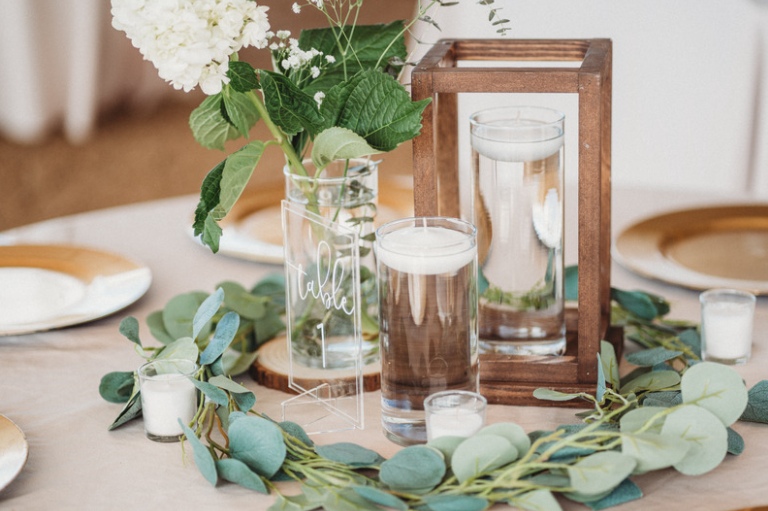
Learn the Craft of Wedding Magic:
5 Tablescape Themes to Dazzle Your Guests
Decorating Business Success: Key Marketing & Networking Strategies
Tablescaping is the art of arranging table settings, encompassing the centerpiece, place settings, cutlery, and decorations, all aimed at curating a specific mood or theme. For weddings, a meticulously designed tablescape can significantly elevate the dining experience, turning the event into a cherished memory.
In this guide, you’ll first delve into five popular wedding themes and discover how to craft tablescapes tailored to each. Following that, we’ll highlight key considerations to keep in mind when conceptualizing a tablescape. To round it off, we’ll highlight some additional pointers to help you approach tablescaping in an organized and efficient manner, ensuring your vision comes to life seamlessly.
Explore this guide on crafting tablescapes for five popular wedding themes:
Classical Elegance
Colours: White, gold, and soft pastels.
- Reasoning: These colors evoke a sense of timeless beauty. White symbolizes purity and innocence, gold adds a touch of luxury, and soft pastels bring in a gentle warmth.
Centerpiece: Tall crystal vases with white roses, lilies, and baby’s breath.
- Reasoning: White flowers like roses and lilies are traditionally associated with weddings due to their elegance. Baby’s breath adds a delicate touch. Crystal vases reflect light beautifully, enhancing the overall ambiance.
Place Settings: White porcelain plates with gold rims, crystal glassware, and gold cutlery.
- Reasoning: Porcelain is a classic choice for formal events. The gold rim and cutlery add a touch of opulence, while crystal glassware complements the vases and adds sparkle.
Decorations: White tablecloth, gold napkin rings, and soft pastel-colored napkins. Candles in crystal holders.
- Reasoning: A white tablecloth provides a neutral base, allowing other elements to stand out. Candles create a romantic atmosphere, and their glow is magnified by crystal holders.

Rustic Romance
Colours: Earthy tones, browns, greens, and muted reds.
- Reasoning: These colors are reminiscent of nature, countryside, and old-world charm, setting the tone for a rustic theme.
Centerpiece: Mason jars or wooden boxes filled with wildflowers, succulents, and twigs.
- Reasoning: Mason jars and wooden boxes are staples in rustic decor. Wildflowers, succulents, and twigs are elements commonly found in the countryside.
Place Settings: Wooden chargers, stoneware plates, mason jar glasses, and vintage silverware.
- Reasoning: Wood and stone materials emphasize the natural, down-to-earth vibe. Vintage silverware adds a touch of nostalgia.

Beach Bliss
Colours: Blues, whites, and sandy beige.
- Reasoning: These colors mirror the beach environment – the blue of the sea, white of the waves, and beige of the sand.
Centerpiece: Glass vases filled with sand, seashells, and starfish.
- Reasoning: These elements are direct representations of the beach, bringing the seaside vibe to the table.
Place Settings: White or light blue plates, clear glassware, and silver or bamboo cutlery.
- Reasoning: The colours and materials are light and breezy, complementing the beach theme.

Bohemian Dream
Decorating Business Success: Key Marketing & Networking Strategies
Colours: Rich jewel tones, purples, reds, and golds.
- Reasoning: Jewel tones are vibrant and lively, reflecting the free spirit of bohemian style.
Centerpiece: Low vases with a mix of colorful wildflowers, pampas grass, and dried lavender.
- Reasoning: The mix of flowers and grasses is eclectic, embodying the bohemian mix-and-match ethos.
Place Settings: Mismatched vintage plates, coloured glassware, and ornate gold cutlery.
- Reasoning: Mismatched elements and vintage items are hallmarks of boho style, emphasizing individuality and artistic expression.

Modern Minimalist
Colours: Monochrome palette, blacks, whites, and grays.
- Reasoning: A monochrome palette is clean, sleek, and undistracting, aligning with the minimalist principle of simplicity.
Centerpiece: Sleek vases with a single type of flower.
- Reasoning: Minimalism is about reducing elements to their essential quality. A single type of flower in a sleek vase is a perfect representation of this.
Place Settings: Square or round plates in solid colours, stemless glassware, and stainless steel or matte black cutlery.
- Reasoning: Solid colours and simple shapes eliminate unnecessary distractions, allowing guests to focus on the experience.

Key Considerations
Lighting
- Details: The right lighting can set the mood for the entire event. It’s not just about visibility, but also about creating ambiance.
- Candles: They offer a soft, romantic glow, making them perfect for evening weddings. Consider varying heights and sizes, or using floating candles in water-filled vases for added drama.
- Fairy Lights: These tiny LED lights, often on a wire, can be woven through centerpieces, around table edges, or draped overhead. They emit a whimsical, starry-night feel.
- Lanterns: These can be placed on tables or hung overhead. They’re especially fitting for outdoor or rustic-themed weddings. The soft light diffused through a lantern can cast beautiful patterns and shadows.
Tip: Always check the venue’s rules regarding open flames, and consider battery-operated candles if necessary.
Personal Touch
- Details: Adding personal touches can make guests feel special and appreciated. It also showcases the couple’s unique style and story.
- Custom Name Cards: Instead of standard printed cards, consider handwritten ones, or use materials that match the wedding theme, like shells for a beach wedding or small logs for a rustic theme.
- Menu Cards: Personalize these by telling a short story or explaining the significance of a particular dish. For instance, if a dish is a family recipe, share its origin.
Tip: Always think of the guest experience. Personal touches should evoke warmth and inclusivity.
Functionality
- Details: While a tablescape’s beauty is vital, its practicality is equally crucial. A functional design ensures guests have a comfortable dining experience.
- Space: Ensure there’s enough elbow room between guests. Overcrowding with decor can make the space feel cramped.
- View: Tall centerpieces, while stunning, might obstruct views across the table. If using tall items, ensure they’re slender or elevated enough so guests can see beneath them.
- Accessibility: Items frequently used, like salt and pepper shakers or condiments, should be easily reachable. Also, ensure that any decorative items are stable and won’t easily topple over.
Tip: Before finalizing the design, sit at the table and experience it from a guest’s perspective. Adjust any elements that feel intrusive or inconvenient.
Texture & Layering
- Details: The tactile experience of a tablescape is just as important as its visual appeal. Different textures can evoke various emotions and set the mood for the event. For instance, a smooth silk can feel luxurious, while rough burlap can feel rustic and grounded.
- Layering: This involves placing different materials on top of each other. For example, a lace runner over a burlap tablecloth can combine elegance with rustic charm. Layering can also be achieved with plates, using chargers beneath dinner plates, or stacking bowls and plates together.
Tip: When mixing materials, think about the overall vibe you want to achieve. Burlap with lace can evoke a rustic elegance, while silk paired with polished wood can feel sophisticated and warm. The key is to strike a balance so no one texture overwhelms the other.
Colour Harmony
- Details: Colours can evoke emotions and set the tone for an event. While a rainbow of colors might seem festive, it can also feel chaotic if not done right. A harmonious color palette brings unity and intentionality to the design.
- Palette Selection: Start with a base or primary colour that aligns with the wedding theme or the couple’s preferences. From there, choose secondary colors that complement the primary shade.
Tip: Neutral tones like beige, gray, or ivory can act as a bridge between vibrant colours, ensuring they don’t clash. For a cohesive look, the colour palette chosen for the tablescape should echo throughout other elements of the wedding, from the flowers to the bridesmaids’ dresses.
Sustainability
- Details: As environmental concerns grow, many couples are looking for ways to reduce the carbon footprint of their weddings. A sustainable tablescape not only minimizes waste but can also add a meaningful touch to the event.
- Eco-friendly Choices: Consider using cloth napkins instead of paper, or bamboo plates instead of plastic. Even small choices can make a difference.
Tip: Locally sourced flowers reduce transportation emissions and often come without the extensive packaging of imported blooms. Digital projections, while high-tech, can reduce paper waste and offer a unique, modern touch to the setting.
Safety First
- Details: While aesthetics are crucial, safety should never be compromised. This is especially true when dealing with open flames, glass, or any other potential hazards.
- Candle Safety: If using candles, ensure they’re placed in sturdy holders and away from flammable materials. Non-drip candles can prevent wax spills that might damage tablecloths or become a sticky nuisance.
Tip: Battery-operated candles can offer the glow without the flame, making them a safer alternative. For tall items or structures, ensure they’re stable and won’t topple over easily, especially in outdoor settings where wind might be a factor.
From Concept to Creation
Crafting a tablescape is an art, blending aesthetics with functionality. It’s a delicate dance of colours, textures, and elements, all coming together to tell a story. While the detailed tips provided offer a structured roadmap, the true essence and heart of the design will always stem from the personal touches and stories infused by the couple.
However, beyond the creative process, efficiency and organization play pivotal roles in bringing your vision to life. Here are some additional pointers to ensure a seamless experience:
- Stay Organized:
As you dive into the process, it’s easy to get overwhelmed with ideas, samples, and choices. Create a mood board or a digital folder with inspirations, color palettes, and items you wish to incorporate. This will not only help you visualize the final look but also streamline your decision-making process. - Vendor Communication:
Regularly staying in touch with vendors is crucial. Whether it’s the florist, the rental company, or the venue manager, clear communication ensures everyone is on the same page. Share your vision, mood board, and specific requirements with them. Schedule periodic check-ins and ask for updates or samples when necessary. - Budgeting:
While it’s tempting to go all out, it’s essential to set a budget for your tablescape. This will help you prioritize elements and make informed decisions. Regularly track your expenses and always have a little buffer for last-minute additions or changes. - Flexibility:
While it’s great to have a clear vision, sometimes things might not go as planned. Maybe a specific flower is out of season, or a particular item is unavailable. Stay flexible and open to alternatives. Often, these unexpected changes can lead to even more beautiful outcomes. - Feedback Loop:
Before finalizing, it might be helpful to get feedback. Share your design with a trusted friend, family member, or even a professional. Fresh eyes might offer valuable insights or catch potential issues. - Timeline:
Start planning your tablescape well in advance. This gives you ample time to source items, especially if they’re unique or custom-made. It also provides a buffer for any unexpected delays.
Tablescaping goes beyond mere arrangement; it’s crafting a story, invoking emotions, and creating unforgettable moments. Though its visual allure captures the gaze, it’s the detailed planning and organization in the background that truly animate it and guarantee its success.











